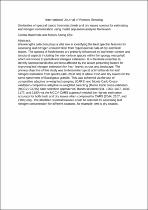 ResearchSpace
ResearchSpace
Similarities of spectral bands from intact fresh and dry leaves spectra for estimating leaf nitrogen concentration using model population analysis framework
JavaScript is disabled for your browser. Some features of this site may not work without it.
- ResearchSpace
- →
- Research Publications/Outputs
- →
- Journal Articles
- →
- View Item
| dc.contributor.author |
Masemola, CecilIa R

|
|
| dc.contributor.author |
Cho, Moses A

|
|
| dc.date.accessioned | 2019-07-30T06:52:27Z | |
| dc.date.available | 2019-07-30T06:52:27Z | |
| dc.date.issued | 2019-03 | |
| dc.identifier.citation | Msemola, C.R., and Cho, M.A. 2019. Similarities of spectral bands from intact fresh and dry leaves spectra for estimating leaf nitrogen concentration using model population analysis framework. International Journal of Remote Sensing, v.40(17), pp 6841-6860. | en_US |
| dc.identifier.issn | 0143-1161 | |
| dc.identifier.issn | 1366-5901 | |
| dc.identifier.uri | https://www.tandfonline.com/doi/full/10.1080/01431161.2019.1597300 | |
| dc.identifier.uri | http://hdl.handle.net/10204/11053 | |
| dc.description | Copyright: 2019 Taylor & Francis. Due to copyright restrictions, the attached PDF file only contains the abstract of the full text item. For access to the full text item, kindly consult the publisher's website. | en_US |
| dc.description.abstract | Wavelengths selection plays a vital role in identifying the best spectral features for assessing leaf nitrogen concentration from hyperspectral data of dry and fresh leaves. The spectra of fresh leaves are primarily influenced by leaf water content and structural aspects including the inter-cellular spaces within the spongy mesophyll, which are known to perturb leaf nitrogen estimation. It is therefore essential to identify spectral bands that are least affected by the above perturbing factors for improving leaf nitrogen estimation for fresh leaves across any landscape. The primary objective of this study was to determine typical optimal bands for leaf nitrogen estimation from spectra (400-2500 nm) of whole fresh and dry leaves for the same specimens of Eucalyptus grandis. This was achieved via the use of competitive adaptive re-weighted sampling (CARS) and Monte Carlo Cross-validation-competitive adaptive re-weighted sampling (Monte Carlo cross-validation (MCCV)-CARS) band selection approaches. Bands selected (931, 1003, 1027, 1036, 1177, and 1180) via the MCCV-CARS approach yielded the highest estimation accuracy for both fresh and dry leaves when compared to CARS (2044, 2107, and 2188) only. The identified spectral features could be relevant for assessing leaf nitrogen concentration for different seasons, for example, wet to dry season. | en_US |
| dc.language.iso | en | en_US |
| dc.publisher | Taylor & Francis | en_US |
| dc.relation.ispartofseries | Worklist;22471 | |
| dc.subject | Remote sensing | en_US |
| dc.subject | Leaf Nitrogen | en_US |
| dc.title | Similarities of spectral bands from intact fresh and dry leaves spectra for estimating leaf nitrogen concentration using model population analysis framework | en_US |
| dc.type | Article | en_US |
| dc.identifier.apacitation | Masemola, C. R., & Cho, M. A. (2019). Similarities of spectral bands from intact fresh and dry leaves spectra for estimating leaf nitrogen concentration using model population analysis framework. http://hdl.handle.net/10204/11053 | en_ZA |
| dc.identifier.chicagocitation | Masemola, CecilIa R, and Moses A Cho "Similarities of spectral bands from intact fresh and dry leaves spectra for estimating leaf nitrogen concentration using model population analysis framework." (2019) http://hdl.handle.net/10204/11053 | en_ZA |
| dc.identifier.vancouvercitation | Masemola CR, Cho MA. Similarities of spectral bands from intact fresh and dry leaves spectra for estimating leaf nitrogen concentration using model population analysis framework. 2019; http://hdl.handle.net/10204/11053. | en_ZA |
| dc.identifier.ris | TY - Article AU - Masemola, CecilIa R AU - Cho, Moses A AB - Wavelengths selection plays a vital role in identifying the best spectral features for assessing leaf nitrogen concentration from hyperspectral data of dry and fresh leaves. The spectra of fresh leaves are primarily influenced by leaf water content and structural aspects including the inter-cellular spaces within the spongy mesophyll, which are known to perturb leaf nitrogen estimation. It is therefore essential to identify spectral bands that are least affected by the above perturbing factors for improving leaf nitrogen estimation for fresh leaves across any landscape. The primary objective of this study was to determine typical optimal bands for leaf nitrogen estimation from spectra (400-2500 nm) of whole fresh and dry leaves for the same specimens of Eucalyptus grandis. This was achieved via the use of competitive adaptive re-weighted sampling (CARS) and Monte Carlo Cross-validation-competitive adaptive re-weighted sampling (Monte Carlo cross-validation (MCCV)-CARS) band selection approaches. Bands selected (931, 1003, 1027, 1036, 1177, and 1180) via the MCCV-CARS approach yielded the highest estimation accuracy for both fresh and dry leaves when compared to CARS (2044, 2107, and 2188) only. The identified spectral features could be relevant for assessing leaf nitrogen concentration for different seasons, for example, wet to dry season. DA - 2019-03 DB - ResearchSpace DP - CSIR KW - Remote sensing KW - Leaf Nitrogen LK - https://researchspace.csir.co.za PY - 2019 SM - 0143-1161 SM - 1366-5901 T1 - Similarities of spectral bands from intact fresh and dry leaves spectra for estimating leaf nitrogen concentration using model population analysis framework TI - Similarities of spectral bands from intact fresh and dry leaves spectra for estimating leaf nitrogen concentration using model population analysis framework UR - http://hdl.handle.net/10204/11053 ER - | en_ZA |





